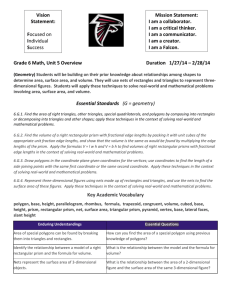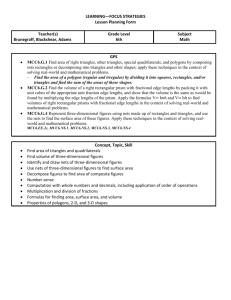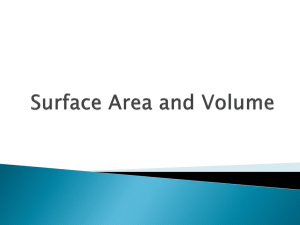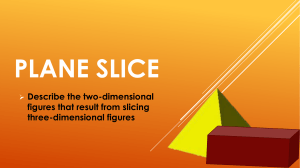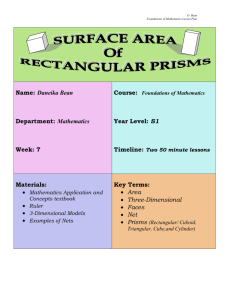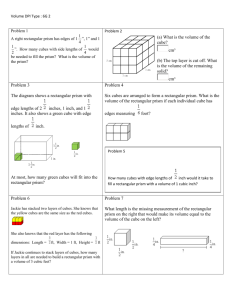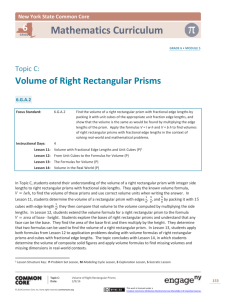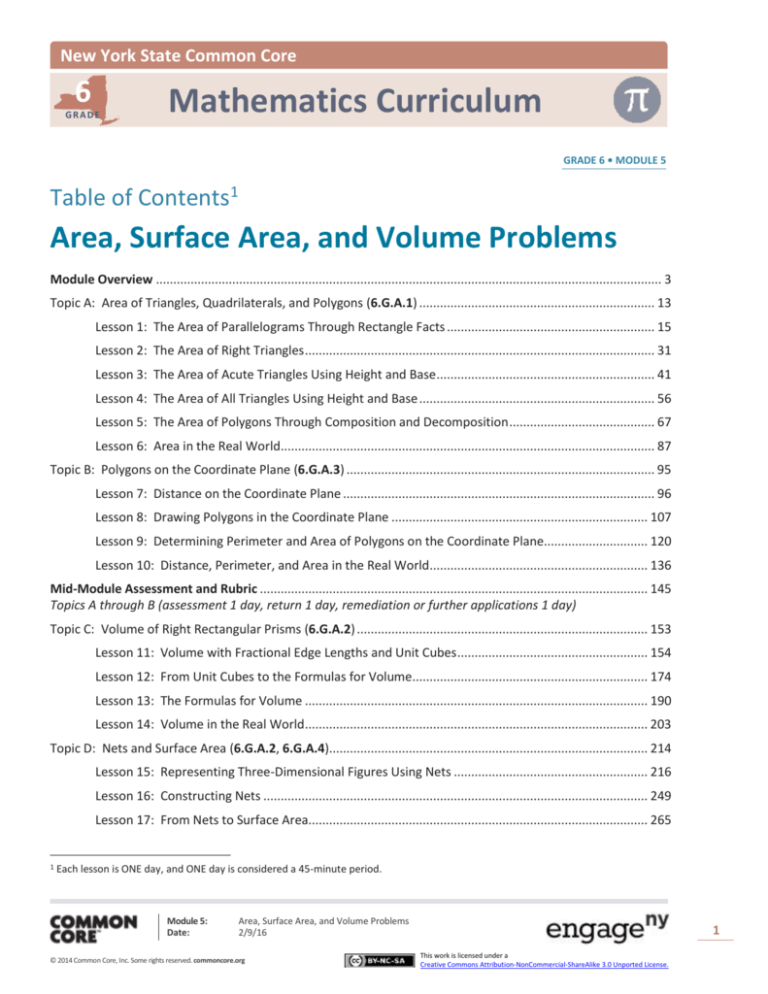
New York State Common Core
6
GRADE
Mathematics Curriculum
GRADE 6 • MODULE 5
Table of Contents1
Area, Surface Area, and Volume Problems
Module Overview .................................................................................................................................................. 3
Topic A: Area of Triangles, Quadrilaterals, and Polygons (6.G.A.1) .................................................................... 13
Lesson 1: The Area of Parallelograms Through Rectangle Facts ............................................................ 15
Lesson 2: The Area of Right Triangles ..................................................................................................... 31
Lesson 3: The Area of Acute Triangles Using Height and Base ............................................................... 41
Lesson 4: The Area of All Triangles Using Height and Base .................................................................... 56
Lesson 5: The Area of Polygons Through Composition and Decomposition .......................................... 67
Lesson 6: Area in the Real World............................................................................................................ 87
Topic B: Polygons on the Coordinate Plane (6.G.A.3) ......................................................................................... 95
Lesson 7: Distance on the Coordinate Plane .......................................................................................... 96
Lesson 8: Drawing Polygons in the Coordinate Plane .......................................................................... 107
Lesson 9: Determining Perimeter and Area of Polygons on the Coordinate Plane.............................. 120
Lesson 10: Distance, Perimeter, and Area in the Real World............................................................... 136
Mid-Module Assessment and Rubric ................................................................................................................ 145
Topics A through B (assessment 1 day, return 1 day, remediation or further applications 1 day)
Topic C: Volume of Right Rectangular Prisms (6.G.A.2) .................................................................................... 153
Lesson 11: Volume with Fractional Edge Lengths and Unit Cubes ....................................................... 154
Lesson 12: From Unit Cubes to the Formulas for Volume.................................................................... 174
Lesson 13: The Formulas for Volume ................................................................................................... 190
Lesson 14: Volume in the Real World................................................................................................... 203
Topic D: Nets and Surface Area (6.G.A.2, 6.G.A.4)............................................................................................ 214
Lesson 15: Representing Three-Dimensional Figures Using Nets ........................................................ 216
Lesson 16: Constructing Nets ............................................................................................................... 249
Lesson 17: From Nets to Surface Area.................................................................................................. 265
1
Each lesson is ONE day, and ONE day is considered a 45-minute period.
Module 5:
Date:
Area, Surface Area, and Volume Problems
2/9/16
© 2014 Common Core, Inc. Some rights reserved. commoncore.org
1
This work is licensed under a
Creative Commons Attribution-NonCommercial-ShareAlike 3.0 Unported License.
NYS COMMON CORE MATHEMATICS CURRICULUM
Module Overview
6•5
Lesson 18: Determining Surface Area of Three-Dimensional Figures .................................................. 280
Lesson 19: Surface Area and Volume in the Real World ...................................................................... 291
Lesson 19a: Addendum Lesson for Modeling―Applying Surface Area and Volume to Aquariums
(Optional) .......................................................................................................................... 303
End-of-Module Assessment and Rubric ............................................................................................................ 317
Topics C through D (assessment 1 day, return 1 day, remediation or further applications 1 day)
Module 5:
Date:
Area, Surface Area, and Volume Problems
2/9/16
© 2014 Common Core, Inc. Some rights reserved. commoncore.org
2
This work is licensed under a
Creative Commons Attribution-NonCommercial-ShareAlike 3.0 Unported License.
NYS COMMON CORE MATHEMATICS CURRICULUM
Module Overview
6•5
Grade 6 • Module 5
Area, Surface Area, and Volume Problems
OVERVIEW
Starting in Grade 1, students compose and decompose plane and solid figures (1.G.A.2). They move to spatial
structuring of rectangular arrays in Grade 2 (2.G.A.2) and continually build upon their understanding of arrays
to ultimately apply their knowledge to two- and three-dimensional figures in Grade 4 (4.MD.A.3) and Grade 5
(5.MD.C.3, 5.MD.C.5). Students move from building arrays to using arrays to find area and eventually move
to decomposing three-dimensional shapes into layers that are arrays of cubes. In this module, students
utilize their previous experiences in shape composition and decomposition in order to understand and
develop formulas for area, volume, and surface area.
In Topic A, students use composition and decomposition to determine the area of triangles, quadrilaterals,
and other polygons. They determine that area is additive. Students learn through exploration that the area
of a triangle is exactly half of the area of its corresponding rectangle. In Lesson 1, students discover through
composition that the area of a parallelogram is the same as a rectangle. In Lesson 2, students compose
rectangles using two copies of a right triangle. They extend their previous knowledge about the area formula
for rectangles (4.MD.A.3) to evaluate the area of the rectangle using 𝐴 = 𝑏ℎ and discover through
manipulation that the area of a right triangle is exactly half that of its corresponding rectangle. In Lesson 3,
students discover that any triangle may be decomposed into right triangles, and in Lesson 4, students further
explore all triangles and discover through manipulation that the area of all triangles is exactly half the area of
its corresponding rectangle. During this discovery process, students become aware that triangles have
altitude, which is the length of the height of the triangle. The altitude is the perpendicular segment from a
vertex of a triangle to the line containing the opposite side. The opposite side is called the base. Students
understand that any side of the triangle can be a base, but the altitude always determines the base. They
move from recognizing right triangles as categories (4.G.A.2) to determining that right triangles are
constructed when altitudes are perpendicular and meet the base at one endpoint. Acute triangles are
constructed when the altitude is perpendicular and meets within the length of the base, and obtuse triangles
are constructed when the altitude is perpendicular and lies outside the length of the base. Students use this
information to cut triangular pieces and rearrange them to fit exactly within one half of the corresponding
1
2
rectangle to determine that the area formula for any triangle can be determined using 𝐴 = 𝑏ℎ.
Module 5:
Date:
Area, Surface Area, and Volume Problems
2/9/16
© 2014 Common Core, Inc. Some rights reserved. commoncore.org
3
This work is licensed under a
Creative Commons Attribution-NonCommercial-ShareAlike 3.0 Unported License.
NYS COMMON CORE MATHEMATICS CURRICULUM
Module Overview
6•5
In Lesson 5, students apply their knowledge of the area of a triangular region, where they deconstruct
parallelograms, trapezoids, and other quadrilaterals and polygons into triangles or rectangles in order to
determine area. They intuitively decompose rectangles to determine the area of polygons. Topic A closes
with Lesson 6 where students apply their learning from the topic to find areas of composite figures in real-life
contexts, as well as to determine the area of missing regions (6.G.A.1).
In Module 3, students used coordinates and absolute value to find distances between points on a coordinate
plane (6.NS.C.8). In Topic B, students extend this learning to Lessons 7 and 8 where they find edge lengths of
polygons (the distance between two vertices using absolute value) and draw polygons given coordinates
(6.G.A.3). From these drawings, students determine the area of polygons on the coordinate plane by
composing and decomposing into polygons with known area formulas. In Lesson 9, students further
investigate and calculate the area of polygons on the coordinate plane and also calculate the perimeter. They
note that finding perimeter is simply finding the sum of the polygon’s edge lengths (or finding the sum of the
distances between vertices). Topic B concludes with students determining distance, perimeter, and area on
the coordinate plane in real-world contexts.
In Grade 5, students recognized volume as an attribute of solid figures. They measured volume by packing
right rectangular prisms with unit cubes and found that determining volume was the same as multiplying the
edge lengths of the prism (5.MD.C.3, 5.MD.C.4). Students extend this knowledge to Topic C where they
continue packing right rectangular prisms with unit cubes; however, this time the right rectangular prism has
fractional lengths (6.G.A.2). In Lesson 11, students decompose a one cubic unit prism in order to
conceptualize finding the volume of a right rectangular prism with fractional edge lengths using unit cubes.
They connect those findings to apply the formula 𝑉 = 𝑙𝑤ℎ and multiply fractional edge lengths (5.NF.B.4). In
Lessons 12 and 13, students extend and apply the volume formula to 𝑉 = The area of the base × height or
simply 𝑉 = 𝑏ℎ, where 𝑏 represents the area of the base. In Lesson 12, students explore the bases of right
rectangular prisms and find the area of the base first, then multiply by the height. They determine that two
formulas can be used to find the volume of a right rectangular prism. In Lesson 13, students apply both
formulas to application problems. Topic C concludes with real-life application of the volume formula where
students extend the notion that volume is additive (5.MD.C.5c) and find the volume of composite solid
figures. They apply volume formulas and use their previous experience with solving equations (6.EE.B.7) to
find missing volumes and missing dimensions.
Module 5 concludes with deconstructing the faces of solid figures to determine surface area. Students note
the difference between finding the volume of right rectangular prisms and finding the surface area of such
prisms. In Lesson 15, students build solid figures using nets. They note which nets compose specific solid
figures and also understand when nets cannot compose a solid figure. From this knowledge, students
deconstruct solid figures into nets to identify the measurement of the solids’ face edges. With this
knowledge from Lesson 16, students are prepared to use nets to determine the surface area of solid figures in
Lesson 17. They find that adding the areas of each face of the solid will result in a combined surface area. In
Lesson 18, students find that each right rectangular prism has a front, a back, a top, a bottom, and two sides.
They determine that surface area is obtained by adding the areas of all the faces. They understand that the
front and back of the prism have the same surface area, the top and bottom have the same surface area, and
the sides have the same surface area. Thus, students develop the formula 𝑆𝐴 = 2𝑙𝑤 + 2𝑙ℎ + 2𝑤ℎ (6.G.A.4).
To wrap up the module, students apply the surface area formula to real-life contexts and distinguish between
the need to find surface area or volume within contextual situations.
Module 5:
Date:
Area, Surface Area, and Volume Problems
2/9/16
© 2014 Common Core, Inc. Some rights reserved. commoncore.org
4
This work is licensed under a
Creative Commons Attribution-NonCommercial-ShareAlike 3.0 Unported License.
NYS COMMON CORE MATHEMATICS CURRICULUM
Module Overview
6•5
Focus Standards
Solve real-world and mathematical problems involving area, surface area, and volume.
6.G.A.1
Find the area of right triangles, other triangles, special quadrilaterals, and polygons by
composing into rectangles or decomposing into triangles and other shapes; apply these
techniques in the context of solving real-world and mathematical problems.
6.G.A.2
Find the volume of a right rectangular prism with fractional edge lengths by packing it with
unit cubes of the appropriate unit fraction edge lengths, and show that the volume is the
same as would be found by multiplying the edge lengths of the prism. Apply the formulas
V = l w h and V = b h to find volumes of right rectangular prisms with fractional edge lengths
in the context of solving real-world and mathematical problems.
6.G.A.3
Draw polygons in the coordinate plane given coordinates for the vertices; use coordinates to
find the length of a side joining points with the same first coordinate or the same second
coordinate. Apply these techniques in the context of solving real-world and mathematical
problems.
6.G.A.4
Represent three-dimensional figures using nets made up of rectangles and triangles, and use
the nets to find the surface area of these figures. Apply these techniques in the context of
solving real-world and mathematical problems.
Foundational Standards
Reason with shapes and their attributes.
1.G.A.2
Compose two-dimensional shapes (rectangles, squares, trapezoids, triangles, half-circles,
and quarter circles) or three-dimensional shapes (cubes, right rectangular prisms, right
circular cones, and right circular cylinders) to create a composite shape, and compose new
shapes from the composite shape.2
2.G.A.2
Partition a rectangle into rows and columns of same-size squares and count to find the total
number of them.
3.G.A.2
Partition shapes into parts with equal areas. Express the area of each part as a unit fraction
of the whole. For example, partition a shape into 4 parts with equal area, and describe the
area of each part as 1/4 of the area of the shape.
Solve problems involving measurement and conversion of measurements from a larger unit
to a smaller unit.
4.MD.A.3
2
Apply the area and perimeter formulas for rectangles in real world and mathematical
problems. For example, find the width of a rectangular room given the area of the flooring
and the length, by viewing the area formula as a multiplication equation with an unknown
factor.
Students do not need to learn formal names such as “right rectangular prism.”
Module 5:
Date:
Area, Surface Area, and Volume Problems
2/9/16
© 2014 Common Core, Inc. Some rights reserved. commoncore.org
5
This work is licensed under a
Creative Commons Attribution-NonCommercial-ShareAlike 3.0 Unported License.
NYS COMMON CORE MATHEMATICS CURRICULUM
Module Overview
6•5
Draw and identify lines and angles, and classify shapes by properties of their lines and
angles.
4.G.A.2
Classify two-dimensional figures based on the presence or absence of parallel or
perpendicular lines, or the presence or absence of angles of a specified size. Recognize right
triangles as a category, and identify right triangles.
Apply and extend previous understandings of multiplication and division to multiply and
divide fractions.
5.NF.B.4
Apply and extend previous understandings of multiplication to multiply a fraction or whole
number by a fraction.
a.
5.NF.B.7
Interpret the product (a/b) × q as a parts of a partition of q into b equal parts;
equivalently, as the result of a sequence of operations a × q ÷ b. For example, use a
visual fraction model to show (2/3) × 4 = 8/3, and create a story context for this
equation. Do the same with (2/3) × (4/5) = 8/15. (In general, (a/b) × (c/d) = ac/bd.)
Apply and extend previous understandings of division to divide unit fractions by whole
numbers and whole numbers by unit fractions.3
Geometric measurement: understand conceptual concepts of volume and relate volume to
multiplication and to addition.
5.MD.C.3
Recognize volume as an attribute of solid figures and understand concepts of volume
measurement.
a.
A cube with side length 1 unit, called a “unit cube,” is said to have “one cubic unit” of
volume, and can be used to measure volume.
b.
A solid figure which can be packed without gaps or overlaps using n unit cubes is said to
have a volume of n cubic units.
5.MD.C.4
Measure volumes by counting unit cubes, using cubic cm, cubic in, cubic ft, and improvised
units.
5.MD.C.5
Relate volume to the operations of multiplication and addition and solve real world and
mathematical problems involving volume.
a.
Find the volume of a right rectangular prism with whole-number side lengths by packing
it with unit cubes, and show that the volume is the same as would be found by
multiplying the edge lengths, equivalently by multiplying the height by the area of the
base. Represent threefold whole-number products as volumes, e.g., to represent the
associative property of multiplication.
b.
Apply the formulas V = l × w × h and V = b × h for rectangular prisms to find volumes of
right rectangular prisms with whole-number edge lengths in the context of solving real
world and mathematical problems.
3
Students able to multiply fractions in general can develop strategies to divide fractions in general, by reasoning about the
relationship between multiplication and division. But division of a fraction by a fraction is not a requirement at this grade.
Module 5:
Date:
Area, Surface Area, and Volume Problems
2/9/16
© 2014 Common Core, Inc. Some rights reserved. commoncore.org
6
This work is licensed under a
Creative Commons Attribution-NonCommercial-ShareAlike 3.0 Unported License.
Module Overview
NYS COMMON CORE MATHEMATICS CURRICULUM
c.
6•5
Recognize volume as additive. Find volumes of solid figures composed of two nonoverlapping right rectangular prisms by adding the volumes of the non-overlapping
parts, applying this technique to solve real world problems.
Graph points on a coordinate plane to solve real-world and mathematical problems.
5.G.A.1
Use a pair of perpendicular number lines, called axes, to define a coordinate system, with
the intersection of the lines (the origin) arranged to coincide with the 0 on each line and a
given point in the plane located by using an ordered pair of numbers, called its coordinates.
Understand that the first number indicates how far to travel from the origin in the direction
of one axis, and the second number indicates how far to travel in the direction of the second
axis, with the convention that the names of the two axes and the coordinates correspond
(e.g., x-axis and x-coordinate, y-axis and y-coordinate).
5.G.A.2
Represent real world and mathematical problems by graphing points in the first quadrant of
the coordinate plane, and interpret coordinate values of points in the context of the
situation.
Classify two-dimensional figures into categories based on their properties.
5.G.B.3
Understand that attributes belonging to a category of two-dimensional figures also belong
to all subcategories of that category. For example, all rectangles have four right angles and
squares are rectangles, so all squares have four right angles.
Apply and extend previous understandings of numbers to the system of rational numbers.
6.NS.C.8
Solve real-world and mathematical problems by graphing points in all four quadrants of the
coordinate plane. Include use of coordinates and absolute value to find distances between
points with the same first coordinate or the same second coordinate.
Reason about and solve one-variable equations and inequalities.
6.EE.B.7
Solve real-world and mathematical problems by writing and solving equations of the form
x + p = q and px = q for cases in which p, q and x are all nonnegative rational numbers.
Focus Standards for Mathematical Practice
MP.1
Make sense of problems and persevere in solving them. Students make sense of realworld problems that involve area, volume, and surface area. One problem will involve
multiple steps without breaking the problem into smaller, simpler questions. To solve
surface area problems, students will have to find the area of different parts of the polygon
before calculating the total area.
MP.3
Construct viable arguments and critique the reasoning of others. Students will develop
different arguments as to why area formulas work for different polygons. Through this
development, students may discuss and question their peers’ thinking process. When
students draw nets to represent right rectangular prisms, their representations may be
Module 5:
Date:
Area, Surface Area, and Volume Problems
2/9/16
© 2014 Common Core, Inc. Some rights reserved. commoncore.org
7
This work is licensed under a
Creative Commons Attribution-NonCommercial-ShareAlike 3.0 Unported License.
NYS COMMON CORE MATHEMATICS CURRICULUM
Module Overview
6•5
different from their peers’. Although more than one answer may be correct, students will
have an opportunity to defend their answers as well as question their peers. Students may
also solve real-world problems using different methods; therefore, they may have to explain
their thinking and critique their peers.
MP.4
Model with mathematics. Models will be used to demonstrate why the area formulas for
different quadrilaterals are accurate. Students will use unit cubes to build right rectangular
prisms and use these to calculate volume. The unit cubes will be used to model that
𝑉 = 𝑙𝑤ℎ and 𝑉 = 𝑏ℎ, where 𝑏 represents the area of the base, are both accurate formulas
to calculate the volume of a right rectangular prism. Students will use nets to model the
process of calculating the surface area of a right rectangular prism.
MP.6
Attend to precision. Students will understand and use labels correctly throughout the
module. For example, when calculating the area of a triangle, the answer will be labeled
units2 because the area is the product of two dimensions. When two different units are
given within a problem, students know to use previous knowledge of conversions to make
the units match before solving the problem. In multi-step problems, students solve each
part of the problem separately and know when to round in order to calculate the most
precise answer. Students will attend to precision of language when describing exactly how a
region may be composed or decomposed to determine its area.
Terminology
New or Recently Introduced Terms
Altitude and Base of a Triangle (An altitude of a triangle is a perpendicular segment from a vertex of
a triangle to the line containing the opposite side. The opposite side is called the base. For every
triangle, there are three choices for the altitude, and hence there are three base-altitude pairs. The
height of a triangle is the length of the altitude. The length of the base is called either the base
length or, more commonly, the base. Usually, context makes it clear whether the base refers to a
number or a segment. These terms can mislead students: base suggests the bottom, while height
usually refers to vertical distances. Do not reinforce these impressions by consistently displaying all
triangles with horizontal bases.)
Cube (A cube is a right rectangular prism all of whose edges are of equal length.)
Hexagon (Given 6 different points 𝐴, 𝐵, 𝐶, 𝐷, 𝐸, and 𝐹 in the plane, a 6-sided polygon, or hexagon, is
the union of 6 segments 𝐴𝐵, 𝐵𝐶, 𝐶𝐷, 𝐷𝐸, 𝐸𝐹, and 𝐹𝐴 such that (1) the segments intersect only at
their endpoints, and (2) no two adjacent segments are collinear. For both pentagons and hexagons,
the segments are called the sides, and their endpoints are called the vertices. Like quadrilaterals,
pentagons and hexagons can be denoted by the order of vertices defining the segments. For
example, the pentagon 𝐴𝐵𝐶𝐷𝐸 has vertices 𝐴, 𝐵, 𝐶, 𝐷, and 𝐸 that define the 5 segments in the
definition above. Similar to quadrilaterals, pentagons and hexagons also have interiors, which can be
described using pictures in elementary school.)
Line Perpendicular to a Plane (A line 𝐿 intersecting a plane 𝐸 at a point 𝑃 is said to be perpendicular
to the plane 𝐸 if 𝐿 is perpendicular to every line that (1) lies in 𝐸 and (2) passes through the point 𝑃.
A segment is said to be perpendicular to a plane if the line that contains the segment is
Module 5:
Date:
Area, Surface Area, and Volume Problems
2/9/16
© 2014 Common Core, Inc. Some rights reserved. commoncore.org
8
This work is licensed under a
Creative Commons Attribution-NonCommercial-ShareAlike 3.0 Unported License.
NYS COMMON CORE MATHEMATICS CURRICULUM
Module Overview
6•5
perpendicular to the plane. In Grade 6, a line perpendicular to a plane can be described using a
picture.)
Parallel Planes (Two planes are parallel if they do not intersect. In Euclidean geometry, a useful test
for checking whether two planes are parallel is if the planes are different and if there is a line that is
perpendicular to both planes.)
Pentagon (Given 5 different points 𝐴, 𝐵, 𝐶, 𝐷, and 𝐸 in the plane, a 5-sided polygon, or pentagon, is
the union of 5 segments 𝐴𝐵, 𝐵𝐶, 𝐶𝐷, 𝐷𝐸, and 𝐸𝐴 such that (1) the segments intersect only at their
endpoints, and (2) no two adjacent segments are collinear.)
Right Rectangular Prism (Let 𝐸 and 𝐸′ be two parallel planes. Let 𝐵 be a rectangular region4 in the
plane 𝐸. At each point 𝑃 of 𝐵, consider the segment 𝑃𝑃′ perpendicular to 𝐸, joining 𝑃 to a point 𝑃′
of the plane 𝐸′. The union of all these segments is called a right rectangular prism. It can be shown
that the region 𝐵′ in 𝐸′ corresponding to the region 𝐵 is also a rectangular region whose sides are
equal in length to the corresponding sides of 𝐵. The regions 𝐵 and 𝐵′ are called the base faces (or
just bases) of the prism. It can also be shown that the planar region between two corresponding
sides of the bases is also a rectangular region called the lateral face of the prism. In all, the boundary
of a right rectangular prism has 6 faces: the 2 base faces and 4 lateral faces. All adjacent faces
intersect along segments called edges—base edges and lateral edges.)
Surface of a Prism (The surface of a prism is the union of all of its faces—the base faces and lateral
faces.)
Triangular Region (A triangular region is the union of the triangle and its interior.)
Familiar Terms and Symbols5
4
5
Angle
Area
Length of a Segment
Parallel
Parallelogram
Perimeter
Perpendicular
Quadrilateral
Rectangle
Segment
Square
Trapezoid
Triangle
Volume
A rectangular region is the union of a rectangle and its interior.
These are terms and symbols students have seen previously.
Module 5:
Date:
Area, Surface Area, and Volume Problems
2/9/16
© 2014 Common Core, Inc. Some rights reserved. commoncore.org
9
This work is licensed under a
Creative Commons Attribution-NonCommercial-ShareAlike 3.0 Unported License.
NYS COMMON CORE MATHEMATICS CURRICULUM
Module Overview
6•5
Suggested Tools and Representations
Coordinate Planes
Nets
Prisms
Rulers
Rapid White Board Exchanges
Implementing an RWBE requires that each student be provided with a personal white board, a white board
marker, and a means of erasing his or her work. An economic choice for these materials is to place sheets of
card stock inside sheet protectors to use as the personal white boards and to cut sheets of felt into small
squares to use as erasers.
An RWBE consists of a sequence of 10 to 20 problems on a specific topic or skill that starts out with a
relatively simple problem and progressively gets more difficult. The teacher should prepare the problems in a
way that allows him or her to reveal them to the class one at a time. A flip chart or PowerPoint presentation
can be used, or the teacher can write the problems on the board and either cover some with paper or simply
write only one problem on the board at a time.
The teacher reveals, and possibly reads aloud, the first problem in the list and announces, “Go.” Students
work the problem on their personal white boards as quickly as possible and hold their work up for their
teacher to see their answers as soon as they have the answer ready. The teacher gives immediate feedback
to each student, pointing and/or making eye contact with the student and responding with an affirmation for
correct work such as, “Good job!”, “Yes!”, or “Correct!”, or responding with guidance for incorrect work such
as “Look again,” “Try again,” “Check your work,” etc. In the case of the RWBE, it is not recommended that the
feedback include the name of the student receiving the feedback.
If many students have struggled to get the answer correct, go through the solution of that problem as a class
before moving on to the next problem in the sequence. Fluency in the skill has been established when the
class is able to go through each problem in quick succession without pausing to go through the solution of
each problem individually. If only one or two students have not been able to successfully complete a
problem, it is appropriate to move the class forward to the next problem without further delay; in this case
find a time to provide remediation to that student before the next fluency exercise on this skill is given.
Sprints
Sprints are designed to develop fluency. They should be fun, adrenaline-rich activities that intentionally build
energy and excitement. A fast pace is essential. During Sprint administration, teachers assume the role of
athletic coaches. A rousing routine fuels students’ motivation to do their personal best. Student recognition
of increasing success is critical, and so every improvement is acknowledged. (See the Sprint Delivery Script
for the suggested means of acknowledging and celebrating student success.)
One Sprint has two parts with closely-related problems on each. Students complete the two parts of the
Sprint in quick succession with the goal of improving on the second part, even if only by one more.
Module 5:
Date:
Area, Surface Area, and Volume Problems
2/9/16
© 2014 Common Core, Inc. Some rights reserved. commoncore.org
10
This work is licensed under a
Creative Commons Attribution-NonCommercial-ShareAlike 3.0 Unported License.
Module Overview
NYS COMMON CORE MATHEMATICS CURRICULUM
6•5
Sprints are not to be used for a grade. Thus, there is no need for students to write their names on the Sprints.
The low-stakes nature of the exercise means that even students with allowances for extended time can
participate. When a particular student finds the experience undesirable, it is recommended that the student
be allowed to opt-out and take the Sprint home. In this case, it is ideal if the student has a regular
opportunity to express the desire to opt-in.
With practice, the Sprint routine takes about 8 minutes.
Sprint Delivery Script
Gather the following: stopwatch, a copy of Sprint A for each student, a copy of Sprint B for each student,
answers for Sprint A and Sprint B. The following delineates a script for delivery of a pair of Sprints.
This sprint covers: topic.
Do not look at the Sprint; keep it turned face down on your desk.
There are xx problems on the Sprint. You will have 60 seconds. Do as many as you can. I do not expect
any of you to finish.
On your mark, get set, GO.
60 seconds of silence.
STOP. Circle the last problem you completed.
I will read the answers. You say “YES” if your answer matches. Mark the ones you have wrong. Don’t try
to correct them.
Energetically, rapid-fire call the answers ONLY.
Stop reading answers after there are no more students answering, “Yes.”
Fantastic! Count the number you have correct, and write it on the top of the page. This is your personal
goal for Sprint B.
Raise your hand if you have 1 or more correct. 2 or more, 3 or more...
Let us all applaud our runner-up, [insert name], with x correct. And let us applaud our winner, [insert
name], with x correct.
You have a few minutes to finish up the page and get ready for the next Sprint.
Students are allowed to talk and ask for help; let this part last as long as most are working seriously.
Stop working. I will read the answers again so you can check your work. You say “YES” if your answer
matches.
Energetically, rapid-fire call the answers ONLY.
Optionally, ask students to stand, and lead them in an energy-expanding exercise that also keeps the brain
going. Examples are jumping jacks or arm circles, etc., while counting by 15’s starting at 15, going up to 150
and back down to 0. You can follow this first exercise with a cool down exercise of a similar nature, such as
1 1 1 2 5
6 3 2 3 6
calf raises with counting by one-sixths ( , , , , , 1 … ).
Hand out the second Sprint, and continue reading the script.
Module 5:
Date:
Area, Surface Area, and Volume Problems
2/9/16
© 2014 Common Core, Inc. Some rights reserved. commoncore.org
11
This work is licensed under a
Creative Commons Attribution-NonCommercial-ShareAlike 3.0 Unported License.
Module Overview
NYS COMMON CORE MATHEMATICS CURRICULUM
6•5
Keep the Sprint face down on your desk.
There are xx problems on the Sprint. You will have 60 seconds. Do as many as you can. I do not expect
any of you to finish.
On your mark, get set, GO.
60 seconds of silence.
STOP. Circle the last problem you completed.
I will read the answers. You say “YES” if your answer matches. Mark the ones you have wrong. Don’t try
to correct them.
Quickly read the answers ONLY.
Count the number you have correct, and write it on the top of the page.
Raise your hand if you have 1 or more correct. 2 or more, 3 or more, ...
Let us all applaud our runner-up, [insert name], with x correct. And let us applaud our winner, [insert
name], with x correct.
Write the amount by which your score improved at the top of the page.
Raise your hand if you improved your score by 1 or more. 2 or more, 3 or more, ...
Let us all applaud our runner-up for most improved, [insert name]. And let us applaud our winner for most
improved, [insert name].
You can take the Sprint home and finish it if you want.
Assessment Summary
Assessment Type Administered
Format
Standards Addressed
Mid-Module
Assessment Task
After Topic B
Constructed response with rubric
6.G.A.1, 6.G.A.3
End-of-Module
Assessment Task
After Topic D
Constructed response with rubric
6.G.A.1, 6.G.A.2,
6.G.A.3, 6.G.A.4
Module 5:
Date:
Area, Surface Area, and Volume Problems
2/9/16
© 2014 Common Core, Inc. Some rights reserved. commoncore.org
12
This work is licensed under a
Creative Commons Attribution-NonCommercial-ShareAlike 3.0 Unported License.

